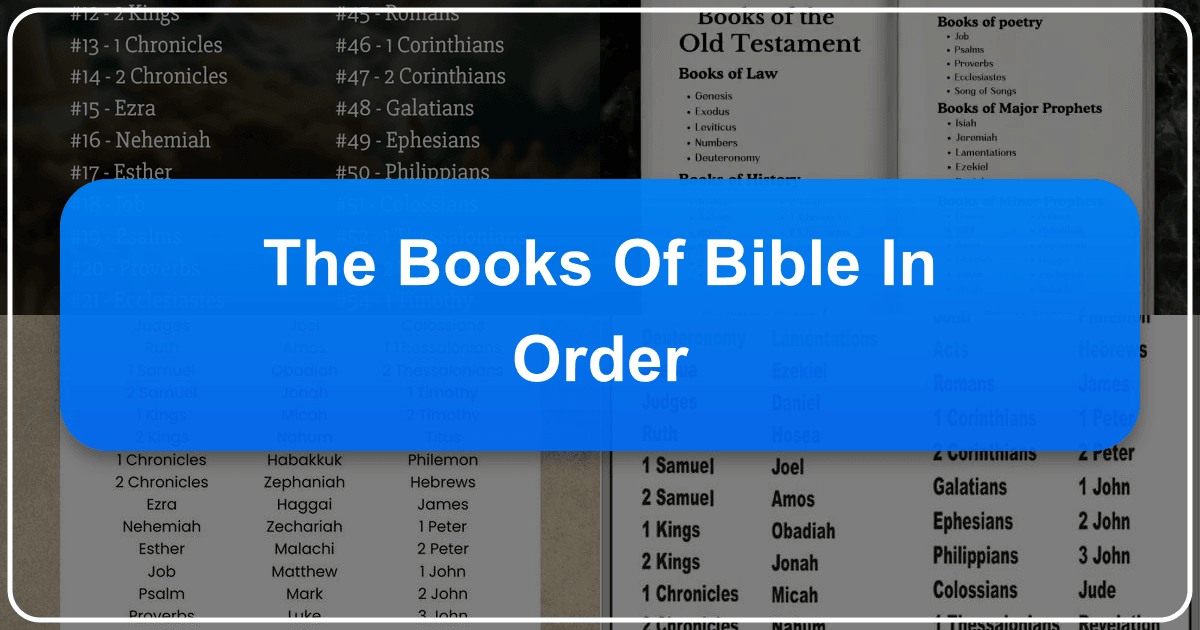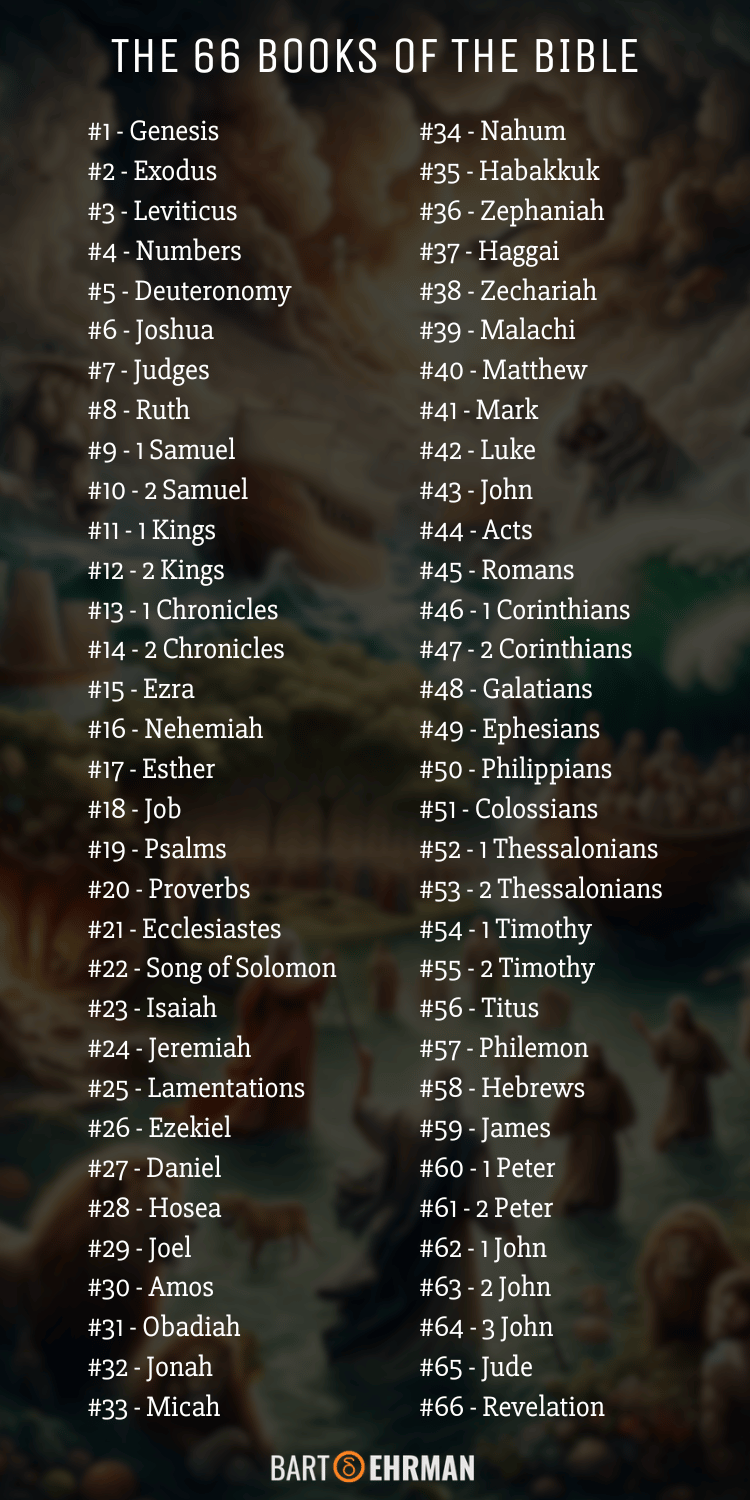The 66 Books of the Bible: A Comprehensive Guide

Navigating the 66 books of the Bible can feel like traversing a vast and ancient landscape. From the creation narratives of Genesis to the apocalyptic visions of Revelation, the collection presents a rich tapestry of genres, styles, and perspectives spanning centuries of human history and religious thought. This comprehensive guide will explore the books of the Bible, not just in their traditional order, but also within the context of their literary genres, historical settings, and enduring cultural impact. We will examine authorship, dating, key themes, and offer concise summaries to enrich your understanding of this foundational text for Judaism and Christianity.

Understanding the Structure of the Bible
The Bible is not a single, chronologically ordered narrative. Instead, it’s a collection of texts compiled over centuries, organized into two main sections: the Old Testament (or Hebrew Bible) comprising 39 books, and the New Testament containing 27 books. The arrangement of books within each Testament reflects literary genre and theological themes rather than strict chronological sequence. This structure, while potentially confusing to a modern reader accustomed to linearly structured narratives, reflects the organic growth and development of biblical literature. Understanding this distinction is crucial for interpreting the Bible effectively.

The books are often categorized into different literary genres, including:
- Law (Torah/Pentateuch): The first five books, traditionally attributed to Moses, lay the foundation for Jewish law and religious practice. These books establish the covenant between God and Israel and provide foundational narratives of creation, the patriarchs, and the exodus from Egypt.
- History: These books chronicle the history of Israel from the conquest of Canaan to the post-exilic period, often intertwining narratives of conquest, leadership, and divine intervention. Key figures include Joshua, the judges, Kings David and Solomon, and the post-exilic leaders Ezra and Nehemiah.
- Poetry/Wisdom Literature: This section showcases various poetic forms, including hymns, prayers, and wisdom sayings, offering reflections on life, faith, and the nature of God. The Psalms, Proverbs, and Ecclesiastes are prime examples.
- Prophecy: Prophetic books, both major and minor, contain oracles and visions communicated by prophets, conveying God’s messages of judgment and hope to both Israel and other nations.
- Gospels: The four Gospels (Matthew, Mark, Luke, and John) narrate the life, teachings, death, and resurrection of Jesus Christ from different perspectives, shaping the foundations of Christian theology.
- Acts of the Apostles: This book chronicles the early spread of Christianity after Jesus’ ascension, focusing on the ministries of Peter and Paul.
- Epistles (Letters): These letters, primarily from Paul to various churches and individuals, address theological issues, provide practical advice, and offer pastoral guidance.
- Apocalyptic Literature: This genre, often characterized by symbolic language and visions, explores themes of eschatology (the end times) and divine judgment. The Book of Revelation exemplifies this category.
The Old Testament: A Closer Look
The Old Testament, also known as the Hebrew Bible, offers a rich and complex narrative encompassing creation, covenant, law, history, poetry, and prophecy. Its books are often divided into further subcategories based on their content:
- The Law (Torah/Pentateuch): Genesis, Exodus, Leviticus, Numbers, Deuteronomy. These foundational books contain the creation account, the story of the exodus, and the legal and ritual code for Israel.
- The Historical Books: Joshua, Judges, Ruth, 1 & 2 Samuel, 1 & 2 Kings, 1 & 2 Chronicles, Ezra, Nehemiah, Esther. These books trace the history of Israel from the conquest of Canaan through the exile and return from Babylon.
- Poetic Books: Job, Psalms, Proverbs, Ecclesiastes, Song of Songs. These books display a variety of poetic styles, exploring themes of wisdom, justice, suffering, and love.
- Prophetic Books: Isaiah, Jeremiah, Lamentations, Ezekiel, Daniel (Major Prophets); Hosea, Joel, Amos, Obadiah, Jonah, Micah, Nahum, Habakkuk, Zephaniah, Haggai, Zechariah, Malachi (Minor Prophets). These books contain pronouncements from various prophets about Israel’s relationship with God, often including messages of judgment and hope.
The New Testament: Exploring the Christian Canon
The New Testament focuses primarily on the life and teachings of Jesus Christ and the emergence and spread of early Christianity. Its books include:
- The Gospels: Matthew, Mark, Luke, John. These four accounts of Jesus’ life provide different perspectives and theological emphases.
- Acts of the Apostles: This book narrates the growth and expansion of the early Christian Church.
- Pauline Epistles: Romans, 1 & 2 Corinthians, Galatians, Ephesians, Philippians, Colossians, 1 & 2 Thessalonians, 1 & 2 Timothy, Titus, Philemon. These letters written by Paul or attributed to him offer guidance and instruction to early Christian communities.
- General Epistles: Hebrews, James, 1 & 2 Peter, 1, 2, & 3 John, Jude. These letters address various issues and offer encouragement to believers.
- Revelation: This apocalyptic book presents symbolic visions of the end times and the ultimate triumph of God.
Authorship and Dating of Biblical Books
Determining the authorship and dating of biblical books is a complex scholarly undertaking, often debated among biblical scholars. While traditional attributions often associate books with specific individuals (such as Moses for the Pentateuch or Paul for many of the epistles), modern scholarship often employs more nuanced approaches, acknowledging the possibility of multiple authors, redactors (editors who compiled and revised existing texts), and anonymous authorship for several books. The dating of biblical texts also involves careful analysis of linguistic, historical, and archaeological evidence, resulting in a range of proposed dates for many of the books. Lbibinders.org provides a wealth of information on these scholarly debates.
Key Themes and Summaries

Each book of the Bible presents unique themes and narratives, contributing to the overall message of the collection. While offering exhaustive summaries for each of the 66 books would extend far beyond the scope of this article, below are some examples illustrating the diverse themes present in the Bible. For more detailed summaries, refer to Lbibinders.org.
Examples of Key Themes and Book Summaries:
- Genesis: Creation, the Fall of humanity, the Patriarchs (Abraham, Isaac, Jacob, Joseph), promises to Abraham, and the Israelites’ journey to Egypt.
- Exodus: The Israelites’ liberation from slavery in Egypt, the giving of the Law at Mount Sinai, and the journey to the Promised Land.
- Psalms: A collection of hymns, prayers, and poems expressing a wide range of human emotions and experiences in relationship with God.
- Isaiah: Prophetic pronouncements concerning the fate of Judah, including warnings of judgment and promises of future restoration.
- Matthew: Presents Jesus as the fulfillment of Old Testament prophecy, emphasizing his teachings and ministry to the Jewish people.
- Romans: Paul’s comprehensive theological treatise on justification by faith, salvation, and the life of the Christian believer.
- Revelation: Apocalyptic visions of the end times, the final judgment, and the establishment of God’s kingdom.
The Cultural Impact of the Bible
The Bible’s influence on Western culture and civilization is undeniable. Its narratives, characters, and moral teachings have shaped art, literature, music, law, and social thought for millennia. The Bible has been translated into countless languages, adapted into various media (film, theater, literature), and inspired countless works of art, music, and literature. Its ethical principles continue to be debated and discussed, shaping moral discourse across diverse cultures and beliefs.
The Bible in Different Versions and Traditions
It is essential to acknowledge the Bible exists in various versions and translations, reflecting the complex history of its textual transmission. The differences between these versions are sometimes significant, leading to interpretive variations and even theological disputes. Moreover, the canon (the list of accepted books) itself varies slightly between different religious traditions (Protestant, Catholic, Orthodox Judaism). Lbibinders.org provides valuable resources for understanding these variations.
Conclusion
The Bible is a complex and multifaceted collection of texts that has profoundly impacted human history and culture. Understanding its structure, literary genres, historical context, and diverse interpretations is crucial for appreciating its enduring significance. This comprehensive overview serves as a starting point for exploring the richness and depth of this timeless collection of sacred texts. For further study and exploration, Lbibinders.org offers a wealth of resources to guide you on your journey through the world of the Bible.